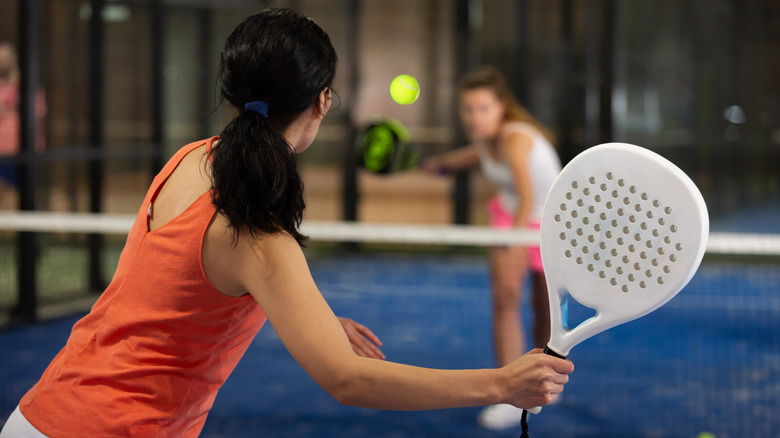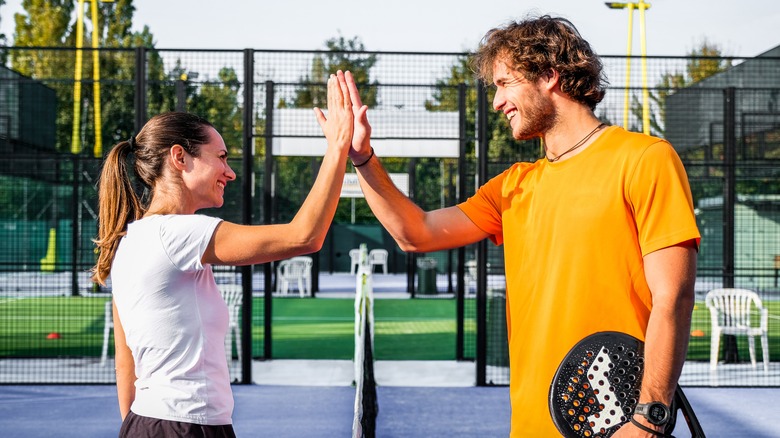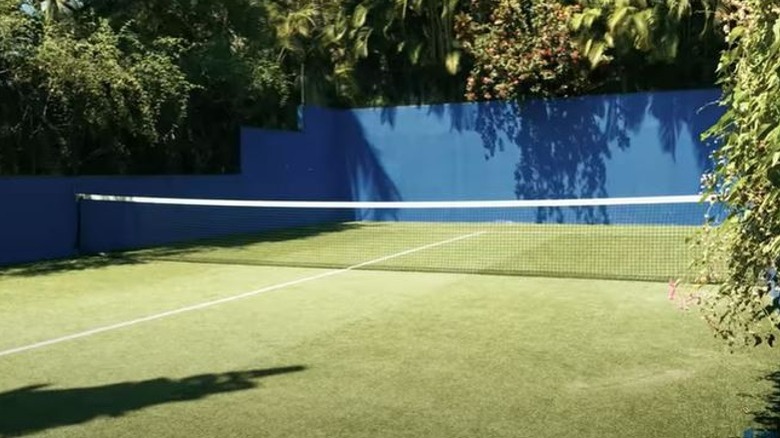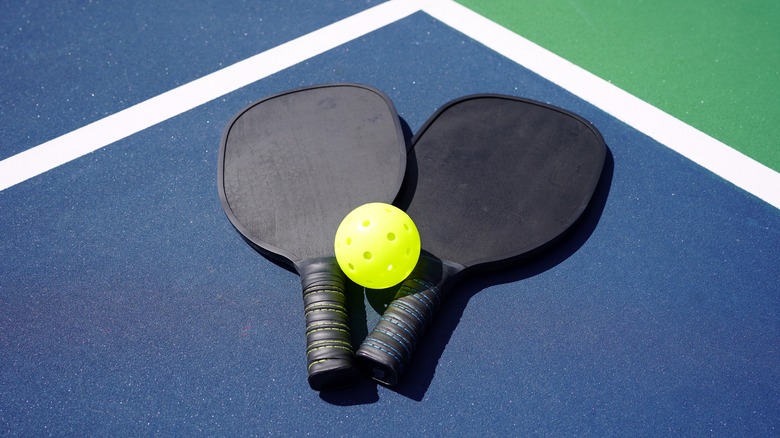Wait, What's Padel? All About The Sport Coming For Pickleball
It seems that every year, a new trend emerges, whether it's in cosmetics, fashion, hairstyles, or sports. The world has seen dozens of new sports surface over the centuries, many of which have gained popularity beyond their country of origin. Case in point: Pickleball. It originated near Seattle, Washington, in the 1960s, but is now played all over the world, per USA Pickleball. And just as pickleball piqued the interest of non-Americans, a non-American sport similar to pickleball has gained the attention of Americans: padel (pa-DELL).
Perhaps you've heard of it, but don't know much about it, or you've seen people playing it but weren't sure of the sport's name. If you haven't heard of it or seen anyone playing it, it's probably because it hasn't been popular in the United States for very long. According to Padel Academy, a Mexican businessman named Enrique Corcuera created the first padel court in his Acapulco home around the same time that pickleball was invented (1969).
The two sports share a few common elements, but they also have some key differences. Although Americans have been playing pickleball since the 1960s, they've been playing padel (in the U.S.) only since the 1990s. It took about 20 years for it to gain popularity in the States, and now, the sport is quickly attracting new players every month.
How padel was created
Padel Magazine featured a story on the history of padel that included World Padel Tour video interviews with Enrique Corcuera's widow, Viviana, and their friends. In 1969, Corcuera converted the courtyard of his Acapulco beach resort into a miniature tennis court so he and his pals could play fronton (a sport that involves hitting a ball against a wall). He later added walls that stood about nine feet tall around it, one at a time, eventually making the area comparable to a squash or racquetball court. Then came the net, making it more like a tennis court.
When the first padel games were played in Corcuera's Acapulco courtyard in the '60s and '70s, the activity didn't have a name. Manuel Arango, Corcuera's friend, helped create a rule book for the game and initially named it "rebotenis," or rebound tennis. Before this time, the nameless sport had already made its way to Argentina, where players were calling it "paddle." However, after some discussion with players from various countries, it was decided to call it "padel" to eliminate confusion.
Padel can be thought of as a fusion of tennis and squash. It's similar to tennis in that it involves using a racket to hit a small ball over a net. It's like squash in that you hit the ball against the walls of an enclosed court.
The evolution of padel
Certain aspects of padel have changed over the years, including the equipment, court, and popularity of the sport. In terms of equipment, the first padel games were played with tennis rackets, but they didn't give the action against the walls that Corcuera wanted, so he replaced them with wooden rackets (via Padel Magazine). Modern padel rackets feature a carbon frame, fiberglass or carbon fiber face, and a rubber core. Materials vary, depending on your skill level, as Everything Padel explains.
Padel courts have also changed since the courts of the '60s and '70s. Modern court walls are made of a transparent or solid material like glass or brick, but the very first padel court walls were made only of solid, non-transparent material. In fact, one of the oldest padel courts in the world, built in 1976 in Manuel Arango's home (the man who named the sport), features solid blue walls.
Another component of padel that's evolved? The traction it's gained around the globe. From Mexico, Argentina, and Spain, the sport is now also played in Portugal, Sweden, the United Kingdom, and the United Arab Emirates, according to Everything Padel. And thanks to a pair of tennis enthusiasts and businessmen – one of whom hailed from Argentina — padel was introduced to the United States in 1994 (via The Houstonian Club).
Padel vs. pickleball
Although pickleball was invented just a few years before padel, pickleball did not directly inspire padel. Still, they share a few similarities. They both involve a racket, a ball, and a court-dividing net, but that's pretty much the extent of their similarities. The two sports are actually more different than they are alike in their courts, court restrictions, equipment, and scoring.
One of the most obvious differences between the sports is the court, as World Padel Insider explains. A padel court includes walls (upon which you can hit the ball), but a pickleball court doesn't, and each court comes with some restrictions. A standard padel court requires four players, two per side, while a pickleball court can accommodate two or four players. However, with a pickleball court, there are certain areas of the court that you are not allowed to enter. These areas are referred to as the "kitchen," or the non-volley zone. A padel court has no such restrictions.
The equipment and scoring of each sport also differ. A pickleball ball is usually made from plastic and has holes in it while a padel ball is very similar to a tennis ball. A padel racket also has holes, but a pickleball racket doesn't. In terms of scoring, padel scoring is exactly the same as tennis, but pickleball scoring resembles ping pong scoring. Although padel is spreading quickly all over the world, no rule says you can't play — and enjoy – both sports.



